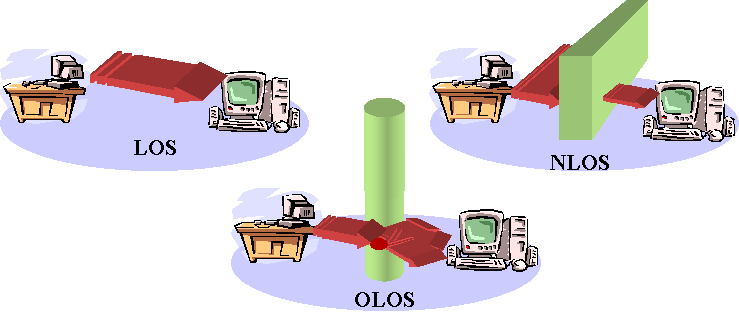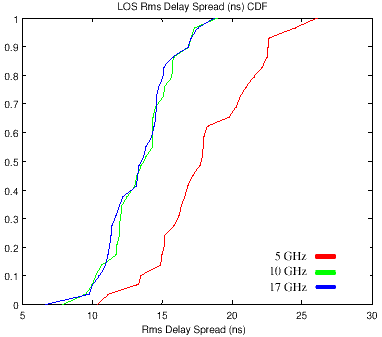

|
Wireless CommunicationChapter: Network Concepts and
Standards
|
17GHz channel characteristics

The 17GHz channel, though LOS (Line Of Sight) is the main propagation carrier, support also NLOS (Non Line Of Sight) links in a short range, as those that could be caused by small obstructions due to people movements or small objects present in the same short-range distance (i.e. room).
OLOS (Obstructed Line of Sight) propagation is handled in short distances, though presence of big obstruction (i.e. walls) at a certain distance (say 5 meters) from emitting source causes a significant drop in receivable power beyond them. Such wall-confined nature of 17GHz propagation at given power transmission is anyway a desirable feature as it allows very dense frequency reuse (thus supporting increase of spatial efficiency over covered areas) and provides intrinsic security in both office/house neighbours.

Figure 3 shows RMS delay spread cumulative distribution function at different frequencies 5 GHz, 10.5 GHz and 17 GHz in a typical short range networking scenario.
Different materials as brick, metallic glass, soft internal walls or wooden surfaces have been considered in the evaluations. The path loss model has been calculated following the well-known lognormal shadowing effect around the mean value, for which an exponential variation of the received power with the distance has been considered.
The behaviour of wireless channels changes with the frequency, in particular the rms delay spread of the channel impulse response, as the frequency increases, at the same distance, tends to be much lower.
This channel characteristic allows to achieve, in the same short ranges, better OFDM design (WIND-FLEX has 20% better spectral efficiency than 802.11a at the PHY layer), as guard time can be made significantly smaller and also, being coherence bandwidth equal to 5 times mean rms delay, much wider subcarrier range, or on the other hand, easier OFDM equalisation.